Porto-North-Portugal.com
The best independent guide to north Portugal
Porto-North-Portugal.com
The best independent guide to north Portugal
Bom Jesus do Monte, Braga
Rising dramatically above the historic city of Braga, the Sanctuary of Bom Jesus do Monte stands as one of Portugal's most spectacular religious sites. This UNESCO World Heritage site combines breathtaking Baroque architecture, spiritual significance, and engineering ingenuity in a setting that has drawn pilgrims and visitors for over 600 years.
More than just a church on a hill, Bom Jesus do Monte represents a masterpiece of landscape architecture where nature, faith, and human creativity merge into something extraordinary. The sanctuary's famous zigzagging staircase, crowned by a magnificent basilica, creates one of Europe's most dramatic religious experiences.
Located on Mount Espinho's slopes overlooking Braga, this sacred site offers visitors a unique journey through Portuguese history, religious art, and spectacular natural beauty. Whether you arrive as a pilgrim, history enthusiast, or simply seeking Portugal's most Instagram-worthy staircase, Bom Jesus delivers an unforgettable experience that captures the essence of Portuguese spirituality and artistic achievement.
Related article: Sights of Braga
The Must-See Highlights of Bom Jesus do Monte
The Baroque Staircase (Escadaria Barroca) - The sanctuary's highlight is its monumental staircase, a stunning 573-step Via Crucis that zigzags up Mount Espinho in three distinct sections. This isn't merely a path to the top but a carefully designed spiritual journey representing purification of the senses and embrace of divine virtues.
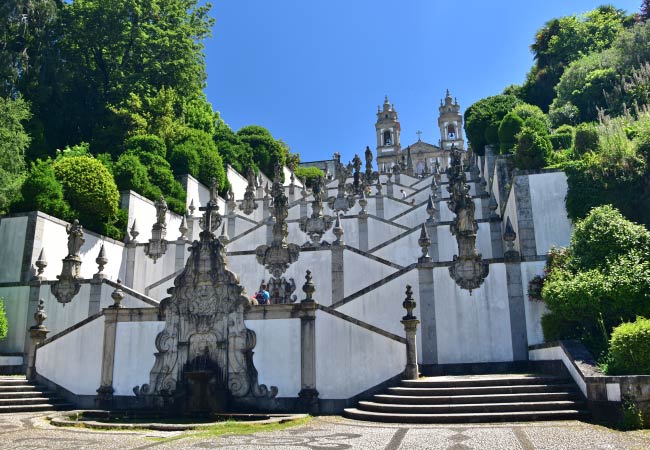
The Water-Powered Funicular - Dating to 1882, the Elevador do Bom Jesus is the world's oldest water-balanced funicular still operating with its original system. This elegant engineering marvel uses gravity and water tanks to transport visitors up the 274-meter track in just three minutes.
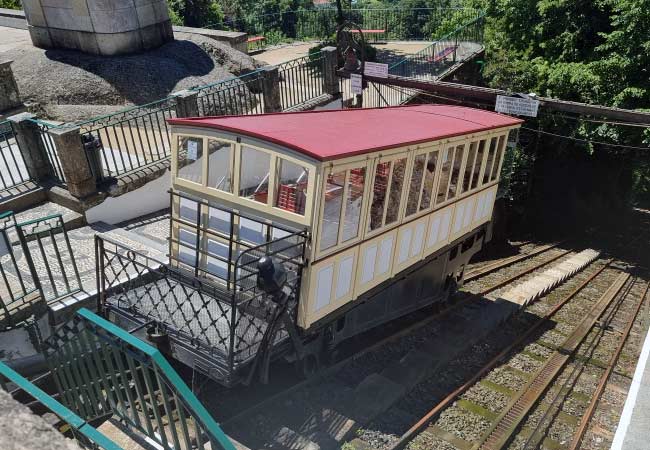
The Neoclassical Basilica - Crowning the sanctuary is the magnificent Basilica, built between 1784-1811 by architect Carlos Amarante. This landmark represents one of Portugal's first Neoclassical churches, with its granite facade, twin bell towers, and elegant proportions creating a powerful architectural climax.
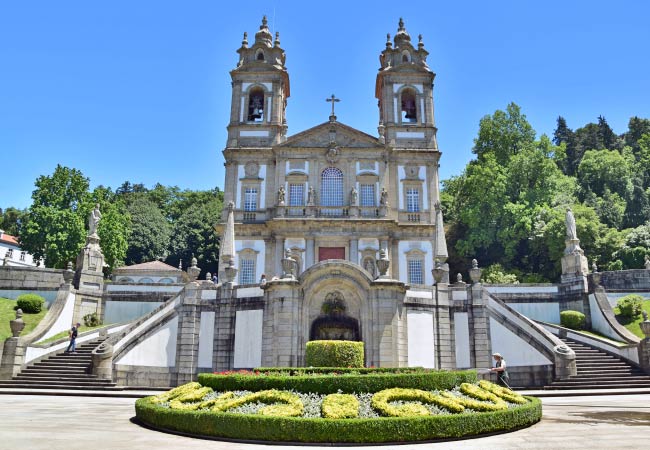
Crucifixion altarpiece - The Altar in the Basilica is not a traditional altarpiece but a dramatic three-dimensional diorama of Mount Calvary with life-sized figures depicting the Crucifixion, a theatrical masterpiece that completes the pilgrimage experience.
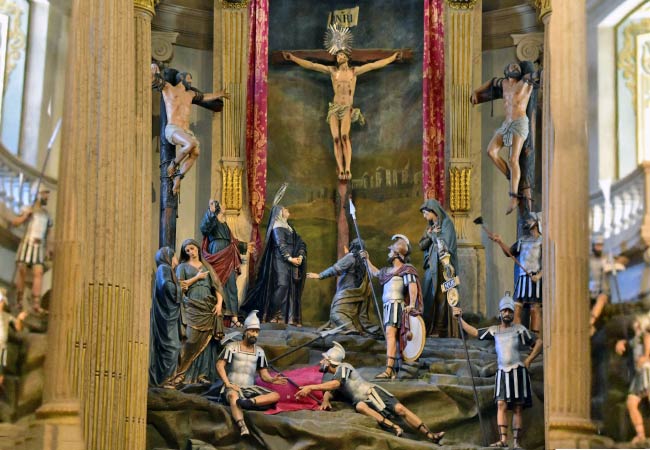
Visitor Information: Opening Hours, Costs & Practicalities
Opening Hours & Admission Fees:
Sanctuary Grounds: The outdoor areas including the famous staircase, park, and walking paths are accessible 24/7 throughout the year and there is no charge.
Basilica: The church opens from 08:00 to 19:00 during summer months, with slightly reduced winter hours of 09:00 to 18:00. Entry to the Basilica is completely free.
Funicular (Elevador): The historic water-powered funicular operates from 09:00 to 20:00 in summer (winter 09:00-18:00). There are two departures every hour, with more frequent services running when the funicular is full. A one-way ticket costs €2.50, while a round-trip ticket is €4.00.
Bell Tower & High Choir: Open from 08:00 to 12:30 and 14:00 to 19:00 in summer (winter hours end at 18:00). Entry costs €1.00 per person, though visits are prohibited during mass times.
Facilities
The complex includes several hotels (Hotel do Templo, Hotel do Elevador), cafés with terrace views, public toilets, and designated picnic areas within the park.
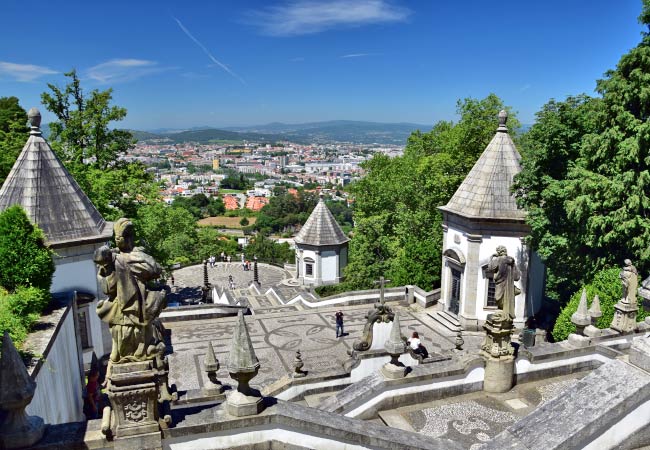
Best Times to Visit
For the most serene experience, arrive early morning around 9:00 before tourist groups arrive. Alternatively, sunset visits offer magical lighting as the setting sun bathes the white granite facades in warm golden and pink hues. Avoid peak afternoon hours, especially in summer, when crowds and heat can diminish the experience.
Visitor Strategy
The recommended approach for first-time visitors is taking the funicular up and walking down the staircase. This conserves energy for exploring the Basilica and upper park while ensuring you experience the full symbolic journey of descent through the chapels, fountains, and iconic staircase perspectives.
Accessibility Information
The sanctuary welcomes all visitors, though the famous staircase presents obvious challenges for those with mobility limitations. The funicular provides the primary accessible route to the summit, while the upper grounds including the Basilica and main park areas are largely wheelchair accessible.
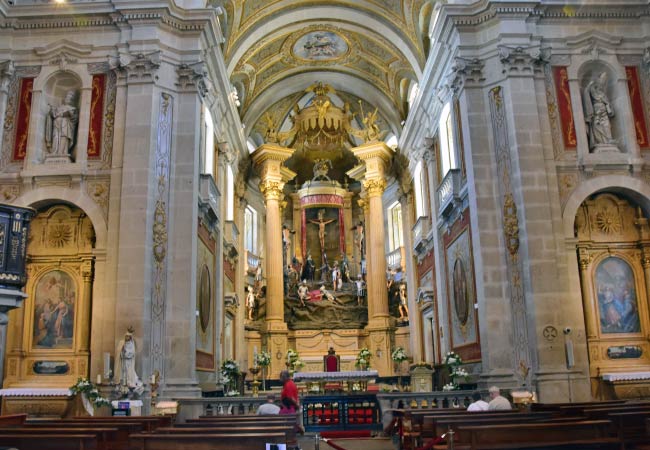
Transportation Options
Public Bus
The most economical choice at approximately €2.00 per person, Route #2 operated by Transportes Urbanos de Braga (TUB) takes around 25 minutes to reach the sanctuary. Buses depart every 30 minutes on weekdays (hourly on Sundays) from key stops including Avenida da Liberdade and near Braga train station, making it convenient for visitors arriving from Porto. The bus terminates directly at the sanctuary base, adjacent to both the funicular station and staircase entrance.
Uber/Bolt
These popular ride-sharing services operate in Braga and often prove slightly cheaper than traditional taxis, typically costing between €5.00 and €7.00 for the 10-minute journey. This can be a good option if you are travelling as a group or are limited for time.
By car
Driving offers maximum flexibility for exploring the region, with the journey taking approximately 10 minutes from Braga's center. However, parking options are limited; there is restricted free parking at the sanctuary's base, while paid parking is available at the summit near the Basilica and hotels
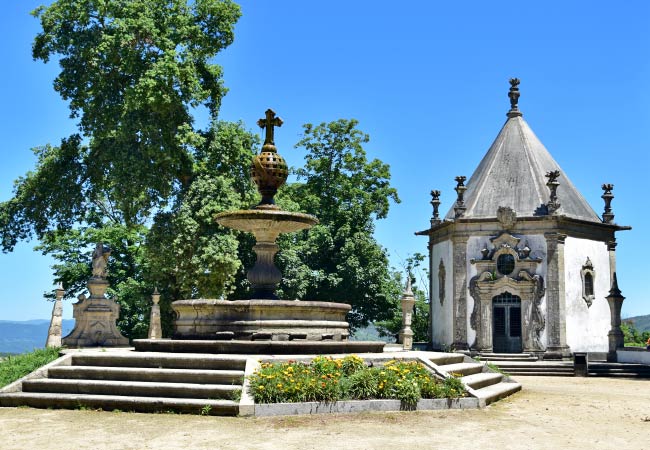
The Jardins do Santuário do Bom Jesus
Exploring the Sanctuary Complex
The Sacred Way (Via Sacra)
The monumental staircase functions as a Via Crucis, a sacred path of penance and meditation designed to guide pilgrims through a complex theological program. The ascent covers 116 vertical meters through three distinct sections, each with its own spiritual significance and architectural character.
The Portico Stairway (376 steps) begins the journey through a shaded, wooded path punctuated by 19 chapels containing life-sized terracotta dioramas depicting Christ's Passion. These dramatic sculptural groups, rendered with striking realism, serve as meditation stations immersing visitors in the narrative of Christ's suffering.
The Stairway of the Five Senses (104 steps) represents the journey's most emblematic section - a majestic double-flight staircase zigzagging up the mountainside. Each of the five landings features elaborate granite fountains where water emerges from the corresponding sensory organ of sculpted figures, symbolizing the purification necessary for spiritual enlightenment.
The Stairway of the Three Virtues (93 steps) completes the ascent in Neoclassical style, representing Faith, Hope, and Charity through three final fountains before reaching the Basilica courtyard.
The Sanctuary Complex
Beyond the famous staircase, the summit contains additional courtyards that continue the religious narrative. The Terreiro de Moisés (Court of Moses) features the symbolic Pelican Fountain and the unique stone equestrian statue of Saint Longinus, Portugal's only such sculpture carved entirely from granite.
The Terreiro dos Evangelistas (Court of the Evangelists) behind the Basilica focuses on post-Resurrection events through octagonal chapels and four Baroque fountains, each crowned by statues of the Evangelists, completing the site's comprehensive Christian narrative.
Gardens & Grounds
The 19th-century park transformation added leisure elements to the religious site. Highlights include the artificial grotto with stalactites designed by Swiss architect Ernest Korrodi, the picturesque lake with rental boats, and numerous walking trails through forests of native and exotic trees. The grounds offer multiple viewpoints with panoramic vistas across Braga and the surrounding Minho region.
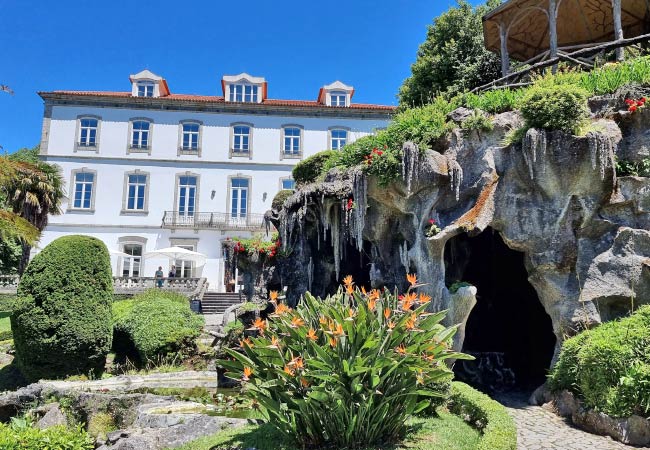
The Gruta Artificial de Ernesto Korrodi
The Funicular Railway
The Elevador do Bom Jesus stands as a testament to 19th-century Portuguese engineering ingenuity. Inaugurated on March 25, 1882, this water-balanced funicular operates entirely without electricity using an elegantly simple gravity system.
Two cabins on parallel tracks each contain large water tanks beneath their floors. The system works by filling the upper cabin's tank with precisely calculated water amounts based on passenger weight. This makes the top cabin heavier than the bottom cabin, and when brakes are released, gravity pulls the heavier cabin down while drawing the lighter cabin up the 274-meter track with its steep 30% gradient.
The smooth, quiet three-minute journey provides spectacular views while representing both practical transport and fascinating historical engineering. Designed by Swiss specialist Nikolaus Riggenbach (who created many of Lisbon's famous funiculars), it remains one of only a handful of original water-balanced funiculars still operating globally.
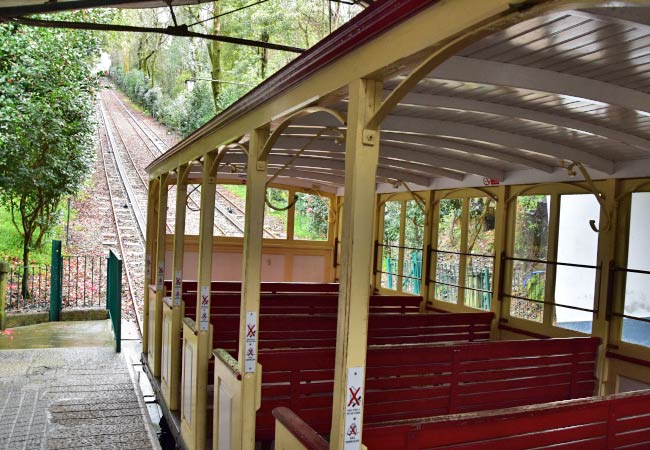
History & Heritage of Bom Jesus do Monte
The story of Bom Jesus do Monte spans over 600 years, transforming from a simple hillside chapel into one of Europe's most spectacular sacred sites.
14th Century - The sanctuary's origins are steeped in legend. Following the Battle of Salado (1340) where Christian forces defeated the Moors, locals reported seeing a miraculous cross appear in the sky above Mount Espinho. The Archbishop of Braga, D. Gonçalo Pereira, whose own son had fought in the battle, led the populace to erect a cross and build the first small chapel dedicated to the Holy Cross around 1373.
15th-16th Centuries - The site's popularity grew steadily. In 1494, Archbishop D. Jorge da Costa commissioned a larger chapel, which was rebuilt again in 1522 by the Dean of Braga Cathedral.
1629 - The Confraternity of Bom Jesus do Monte was officially founded, formalising the pilgrimage and establishing the site as a proper "Sacro Monte. The first small chapels depicting Christ's Passion appeared along the hillside paths, laying the groundwork for the Via Crucis.
1722-1750 - Archbishop Rodrigo de Moura Teles initiated the most dramatic phase of construction, transforming a modest pilgrimage site into a Baroque theatrical masterpiece. His vision was extraordinarily ambitious:
• The Portico entrance with its grand arch
• The forest path with eight chapels containing life-sized terracotta scenes
• The spectacular Stairway of the Five Senses with its symbolic fountains
• A circular Baroque church at the summit (later demolished)
The theological program was remarkably sophisticated, incorporating not just Christian iconography but elements from classical mythology and even alchemy. The Five Senses stairway, with water spouting from eyes, ears, nose, mouth, and hands, created a unique sensory purification ritual found nowhere else in Europe.
1760s - Under the direction of architect André Soares, the Terreiro dos Evangelistas was added behind the church. This innovation extended the story beyond Christ's death to include the Resurrection. The octagonal chapels and Evangelist fountains from this period show exquisite Rococo detailing.
1784-1834 - Archbishop Gaspar de Bragança launched the final major building phase. The old Baroque church, deemed too small, was demolished. In its place rose the current Neoclassical basilica designed by Carlos Amarante, one of Portugal's most celebrated architects.
This wasn't just a bigger church, it was a complete stylistic shift. The clean lines and sober grandeur of the Neoclassical style created a powerful contrast with the Baroque exuberance below. The construction took 27 years, with consecration finally occurring in 1834.
1837 - The final Stairway of the Three Virtues was added in matching Neoclassical style, creating the complete journey from earthly senses through divine virtues to salvation, a theological program of remarkable completeness.
19th Century - The surrounding forest was transformed into a 26-hectare public park with romantic gardens, an artificial lake, and hotels. This shifted Bom Jesus from a purely religious site to a multi-purpose destination combining devotion with leisure.
2015: Pope Francis elevated the church to Minor Basilica status.
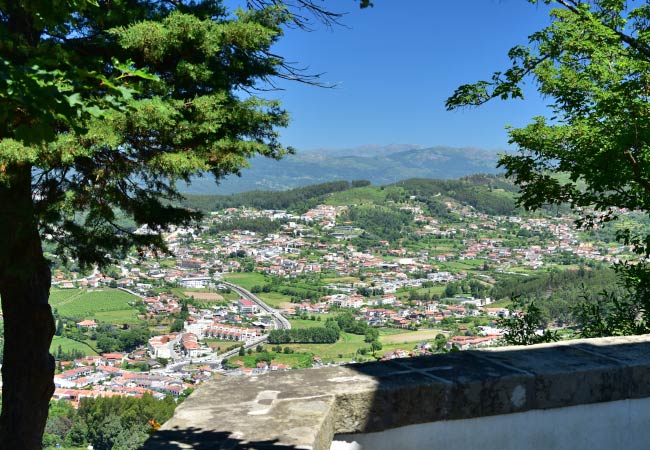
The views over Braga from the Mount Espinho
Santuário de Nossa Senhora do Sameiro
Three kilometres south of Bom Jesus stands the Santuário de Nossa Senhora do Sameiro. This huge complex is devoted to Mary and is Portugal's second-most important Marian shrine after Fátima.
The contrast between Bom Jesus and Senhora do Sameiro couldn't be more striking. Where Bom Jesus impresses with its Baroque beauty, Sameiro does so through sheer scale and white neoclassical grandeur.
Built between 1863 and the 1950s, Sameiro represents 19th-century religious architecture at its most ambitious. The massive white basilica, with its soaring dome, is visible for miles around and can hold 20,000 pilgrims.
The sanctuary attracts enormous crowds during major Marian feast days, particularly on the first Sunday of June and the last Sunday of August, when candlelit processions snake between the two sanctuaries. The interior houses a revered statue of Our Lady, though the building itself feels comparatively modern when contrasted with the decorative Baroque of Bom Jesus.
For visitors, combining both sanctuaries makes perfect sense. The woodland path connecting them offers lovely views and a chance to reflect on how different eras express devotion through architecture. While Bom Jesus tells its story through elaborate symbolism and artistic detail, Sameiro impresses through pure grandeur.























